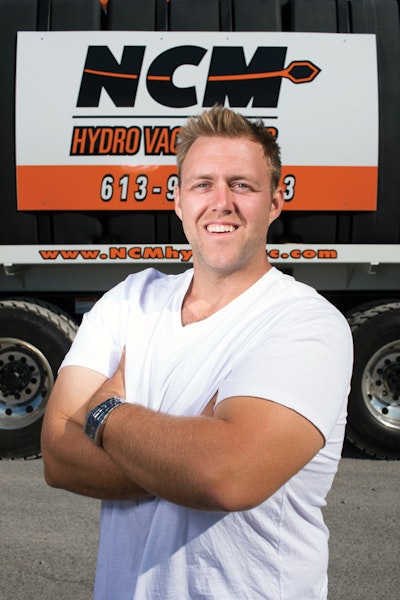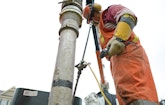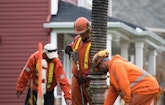
Interested in Trucks?
Get Trucks articles, news and videos right in your inbox! Sign up now.
Trucks + Get AlertsWith a five-generation pedigree of entrepreneurship, Kris Norris was destined to run his own company. So after working three years for his brother’s construction firm, where he oversaw hydroexcavation work, he began looking for his own niche in the industry.
“I thought this would be the way for me to go on my own,” he says. “With my truck, I could work for my brother providing [hydroexcavation] and acquire my own clientele as well.”
Norris opened NCM Hydro Vac Services, with a clear understanding that he had his work cut out for him in metropolitan Ottawa.
With the help of financial backers, he purchased a 2006 Vactor combination unit that was set up for sewer work and hydroexcavation. Its cold-water packet (water boiler) made it possible to dig in Canada year round. With his father, Dana Norris, as his first employee, the duo solicited business by pounding the pavement and talking to anyone and everyone. They also put a full wrap on their truck so it looked like a rolling billboard.
While working for his brother, Norris says he noticed some contractors equipped their trucks with only one type of nozzle and some companies were more productive than others.
“Two different companies working on various sites for us would provide very different production results,” he says. “I was observing and reaching my own judgment call as to their procedures. I was responsible for paying the bills for the carpentry operation. If my division was doing poorly with a large bill at the end of the day it reflected on me. I wanted to make money for the company. When I saw these disparities in the processes, I was always asking ‘why?’ I wanted the best bang for the buck as a consumer. I asked myself, if I were a business owner what would I be looking for in a hydrovac company?”
Render by remote
When Norris began the daunting task of promoting his newly formed company, he faced established competitors with multiple trucks. Prospective customers were skeptical and often told him to come back when he had a second or third unit, which became an essential goal. But in the meantime, he had to press on, so he worked with municipalities and contractors.
“In Canada, we are often required to operate 100 to 500 feet away from the truck while running water lines to cut the soil,” Norris says.
He was able to establish himself as a specialized remote-hole excavation company.
“People would call, saying they had heard we specialized in remote hole digging,” he says. “It is pretty physical, and some competitors are not going after that excavation. We began to take off in Ottawa. I know what nozzles to run for water. I know the proper pressures for vacuuming. I began to vacuum up to 400 feet away with the Vactor 2100. I knew how to use 3800 cfm on the blower side and 2500 psi water cutting pressures.”
From the start, Norris was committed to success. He was fortunate to secure work within the fiber-optics community, as well as municipal work cleaning catch basins and culverts and flushing storm and sewer lines. In Ottawa, many of the old steel culverts are starting to rust and collapse. Large contractors provide relining, and NCM became involved with cleaning culverts, which can run from 40 to 500 feet long, in preparation for the relining.
Operating the business with one truck became a greater issue as more opportunities arose.
Norris began searching for the next piece of equipment for NCM Hydro Vac Services. After a lot of research plus a trip to the 2013 Pumper & Cleaner Environmental Expo International, he found the unit that would set him apart from the competition and make him a leader in the Ottawa region. The Super Products LLC Mud Dog 1600 was the answer. Norris claims it’s the largest and most efficient truck in his region.
“I had done my research and talked with people who had this truck,” he says. “I believed this truck to be powerful, and that it would rip soil from the ground and pull it into the truck. Drier loads mean you will have more material in the debris tank instead of filling it with water.”
He was also looking for a specific type of blower.
“If the blower is not sucking air it won’t move material, and I liked the system on the unit,” he says.
Even with two trucks, Norris faces some daunting competition from companies with multiple trucks and a big footprint in the industry.
“People are beginning to notice my bigger truck and that we can show up and do more work without leaving the site,” he says. “Other units will have 10- or 12-yard debris boxes. These will have to leave the workplace more often to run to a disposal site, while we can stay on the job and make fewer trips. If someone is paying an hourly rate, we can offer the best production in the least amount of time.”
He adds that some of his competitors have up to 18 trucks.
“Here in Ottawa we don’t have a lot of dumps available to take slurry material, so the cost of trucking is an issue. Sometimes there will be a two-hour turn-around time. I wanted to bring a better value to the customer. With a 16-yard debris tank, we can be at a site and work all day and get twice the amount of work as our competitor. Another helpful feature is the ejection plate so you don’t have to spend so much time at the dump pushing out and rinsing a frozen load of mud.”
Norris put his 2014 Super Products Mud Dog into service in late summer 2013. With the vehicle fully prepared for the road with matching wrap and logo, the dual rolling billboards caught the industry’s attention.
The 2014 Super Products truck has a Peterbilt chassis, 16-cubic-yard debris tank and 1,500-gallon water tank. The blower generates vacuum power of 6,000 cfm at 28 inches of mercury. The pump (3,000 psi/18 gpm) is manufactured by Super Products. The 2006 Vactor is on an International chassis with a 12-cubic-yard debris tank, 1,300-gallon water tank and a Vactor blower with 3800 cfm at 17 inches of mercury. The pump (2500 psi/80 gpm) is by Vactor.
“In our area, we have different soil conditions, from sand to stone to assorted clays,” Norris says. “When excavating soils you want to conserve your water by running the proper cutting head with the proper water pressure. When excavating in granular materials like sand or packed stone such as road base, the rotator nozzle works best. In sensitive areas made up of clays and not involving utilities, the one cutter nozzle works best. With utilities in play, the three-tip cutter nozzle works best. The rotator is also used for uncovering costly utilities such as hydro, gas and fiber optics.”
Growth and grit
After six months, Norris was able to hire a second operator.
Hiring the right person is always challenging. Norris has high work standards and expects his employees to understand hazards with the truck and know how to operate with high water pressure.
“I want my technicians to have a lot of drive, and a willingness to work hard,” he says. “This is hard and demanding work. It is not for everyone, and we deal with unusual situations.
“Municipal work can offer surprises, such as operating within train tunnels, sucking up liquids that can be contaminated – where there might be chemical spills – paint residue.
“We had a 100-foot vertical lift down to the train tunnel, and then were sucking up the liquid contaminants another 300 feet in the lateral line. We thought that was pretty amazing.”
The Canadian weather is always a consideration, particularly when it comes to hydroexcavation because the ground can be frozen so deep.
“We had a situation where a waterline under a road had frozen down 11 feet deep, and a nearby subdivision was losing water. The contractor had to strip the asphalt off the road and we excavated a trench in the road down to the water main so we could use hot water to thaw the line and get the water flowing again.”
Part of Norris’s quick climb to success has been his ability to find creative solutions that expand his business.
“We have a roofing contractor who works with high-rise, flat-roof buildings,” Norris says. “These typically will have a pea stone and tar roof. When they are in the process of reroofing, we offer a new option other than using a shovel and a bucket to collect debris that is then craned down and put in a truck for hauling. This is a long procedure that can take up to three days.
“Using our 2006 Vactor we run a disposable plastic hose down the side of the building to the truck and suck up all the debris on the roof into our truck and it is hauled for proper disposal. It’s all one simple procedure. This can be done in six hours. We are presenting this option to other roofing companies.”
While working for a telecommunications company that uses fish tape to push lines through an underground conduit, Norris stepped forward with a plan to move the lines that would reduce labor and time.
“I asked them, why not suck the wires through?” Norris says. “They tied a T-shirt to the end of the wire, and I put our hydrovac 500 feet down the street and sucked the wire all the way through the pipe. In a few minutes, it was done. I had successfully sucked the wire all through the pipe.”
Norris says that when he comes up with these unusual methods, he often worries about looking foolish. However, he continues to explore ways to better serve his customers.
“One of the most satisfying things for me is when we have a large job, with my trucks in full view of everyone, and I know the publicity this provides me,” Norris says. “And I know I am the one doing it and will complete it.”









